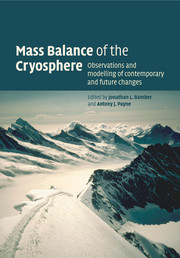Book contents
- Frontmatter
- Contents
- List of contributors
- Foreword
- Preface
- 1 Introduction and background
- Part I Observational techniques and methods
- Part II Modelling techniques and methods
- Part III The mass balance of sea ice
- Part IV The mass balance of the ice sheets
- Part V The mass balance of ice caps and glaciers
- 14 Arctic ice caps and glaciers
- 15 Glaciers and ice caps: historical background and strategies of world-wide monitoring
- 16 Glaciers and the study of climate and sea-level change
- 17 Conclusions, summary and outlook
- Index
- References
15 - Glaciers and ice caps: historical background and strategies of world-wide monitoring
Published online by Cambridge University Press: 16 October 2009
- Frontmatter
- Contents
- List of contributors
- Foreword
- Preface
- 1 Introduction and background
- Part I Observational techniques and methods
- Part II Modelling techniques and methods
- Part III The mass balance of sea ice
- Part IV The mass balance of the ice sheets
- Part V The mass balance of ice caps and glaciers
- 14 Arctic ice caps and glaciers
- 15 Glaciers and ice caps: historical background and strategies of world-wide monitoring
- 16 Glaciers and the study of climate and sea-level change
- 17 Conclusions, summary and outlook
- Index
- References
Summary
Introduction
Throughout the history of modern science, glaciers and ice caps have not only been a source of fascination but also a key element in discussions about Earth evolution and climate change. The discovery of the Ice Age in the late eighteenth and the nineteenth centuries significantly contributed to the understanding of the evolutionary development of the Earth; it also demonstrated the possibility of important climatic changes involving dramatic environmental effects at a global scale. Today, glaciers and ice caps clearly reflect secular warming at a high rate and at a global scale; they are considered key indicators within global climate-related observing systems for early detection of trends potentially related to the greenhouse effect (Figure 15.1; IPCC, 2001). This chapter discusses the historical background, the observational data basis and related monitoring strategies. It also gives some examples, predominantly from low latitude glaciers. More detailed treatment of the theoretical and methodological background can be found in the Chapters 2, 4 and 6. An example of measurements in the Arctic is given in Chapter 14.
Historical background of world-wide glacier monitoring
The internationally co-ordinated collection of information about on-going glacier changes was initiated in 1894 with the foundation of the International Glacier Commission at the Sixth International Geological Congress in Zurich, Switzerland. It was hoped that the long-term observation of glaciers would provide answers to the questions about global uniformity and terrestrial or extra-terrestrial forcing of past, on-going and potential future climate and glacier changes (Forel, 1895).
- Type
- Chapter
- Information
- Mass Balance of the CryosphereObservations and Modelling of Contemporary and Future Changes, pp. 559 - 578Publisher: Cambridge University PressPrint publication year: 2004
References
- 29
- Cited by



